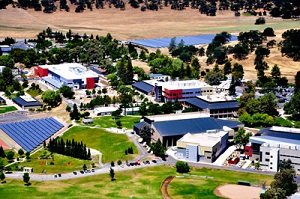Butte College generating more solar power than it uses
 The photovoltaic arrays at Butte College are producing 102 percent of the electricity needed on campus, feeding excess energy back into the grid and generating millions in savings for the university. It’s a first for the nation, the California college said.
The photovoltaic arrays at Butte College are producing 102 percent of the electricity needed on campus, feeding excess energy back into the grid and generating millions in savings for the university. It’s a first for the nation, the California college said.
“The college estimates that it will save between $50 million and $75 million over 15 years, even after accounting for project costs and interest, by eliminating its electricity bill, getting paid for excess electricity production and avoiding future electricity rate increases,” the 12,500 student college said in a press release.
“Butte College has had a longstanding commitment to sustainability. Achieving grid-positive status marks the culmination of years of effort to build Butte College’s supply of solar power and to improve energy efficiency on campus,” Dr. Diana Van Der Ploeg, Butte College president, said in the release.
The college now has more than 4.5 megawatts of photovoltaic generation on campus.
“We’ve completed phase three, which is the biggest part,” said Michael Miller, Butte’s director of facilities planning and management. “We’re at 102 percent. It gives us room if we use a little more. There’s room for growth in all our operations.”
The most recent phase was a 2.7-megawatt system. The first phase was a 1.02 megawatt system, and the second a 850-kilowatt system, Miller said.
The arrays are net-metered with Pacific Gas and Electric Co. (PG&E).
“We get an exponential return on kWh [i.e., kilowatt hours] produced,” Miller said.
During the daytime, the college can sell power to PG&E at a rate of up to 40 cents per kWh, depending on the time of day. When the panels aren’t producing at night, the school buys power off the grid, albeit at a significantly reduced rate.
“At nighttime, it costs us about 8 cents per kWh,” he said. “So that’s the beauty of net metering.”
The college has undergone an extensive shift to sustainability, according to Miller.
“We’ve been doing energy efficiency retrofits since 2002,” he said. “Every year for the last ten years, we’ve been able to reduce our campus natural gas and electric use.”
The cost of the energy efficiency retrofits were also included in the college’s estimated energy savings, Miller said. Retrofits included changing out all the lighting, indoors and out, numerous heating and cooling changes and light and motion sensors, which control both the temperature and lighting of rooms.
“We’re going to continue with the energy conservation efforts,” Miller said. “Energy intensity seems to continue to decrease by about 1.2 percent per year.”



